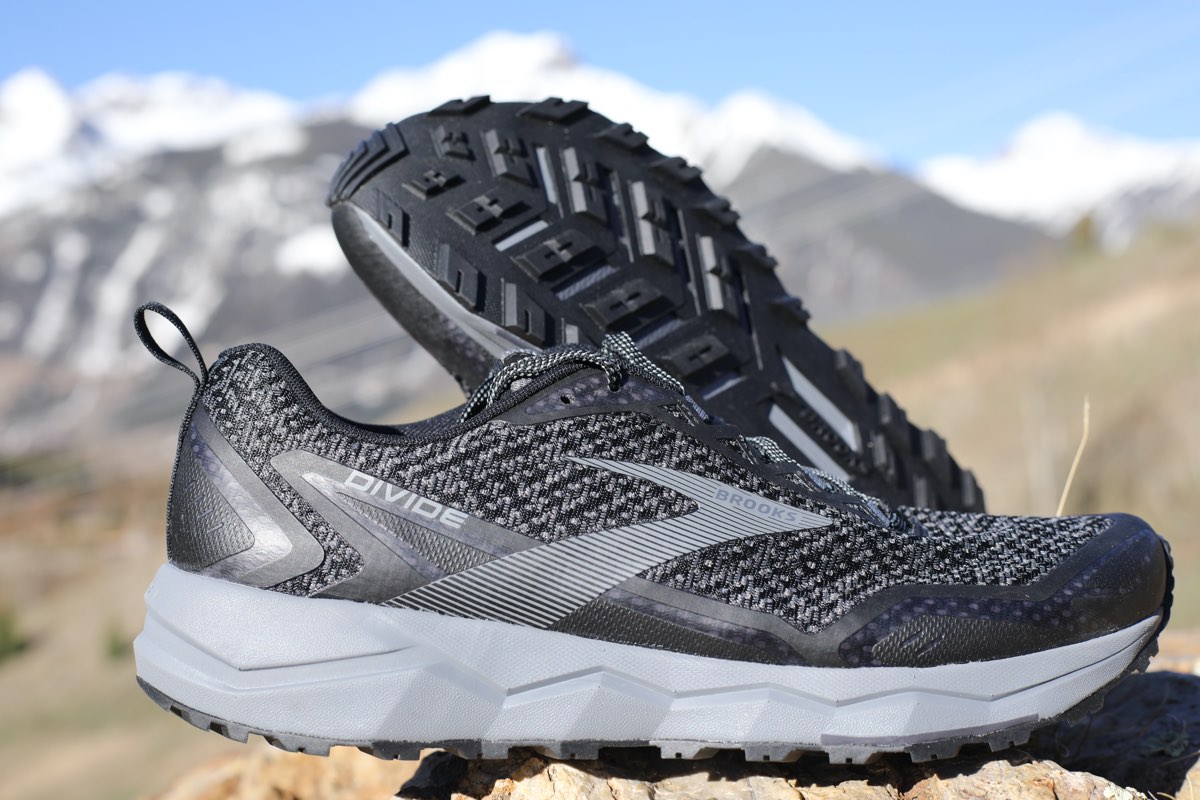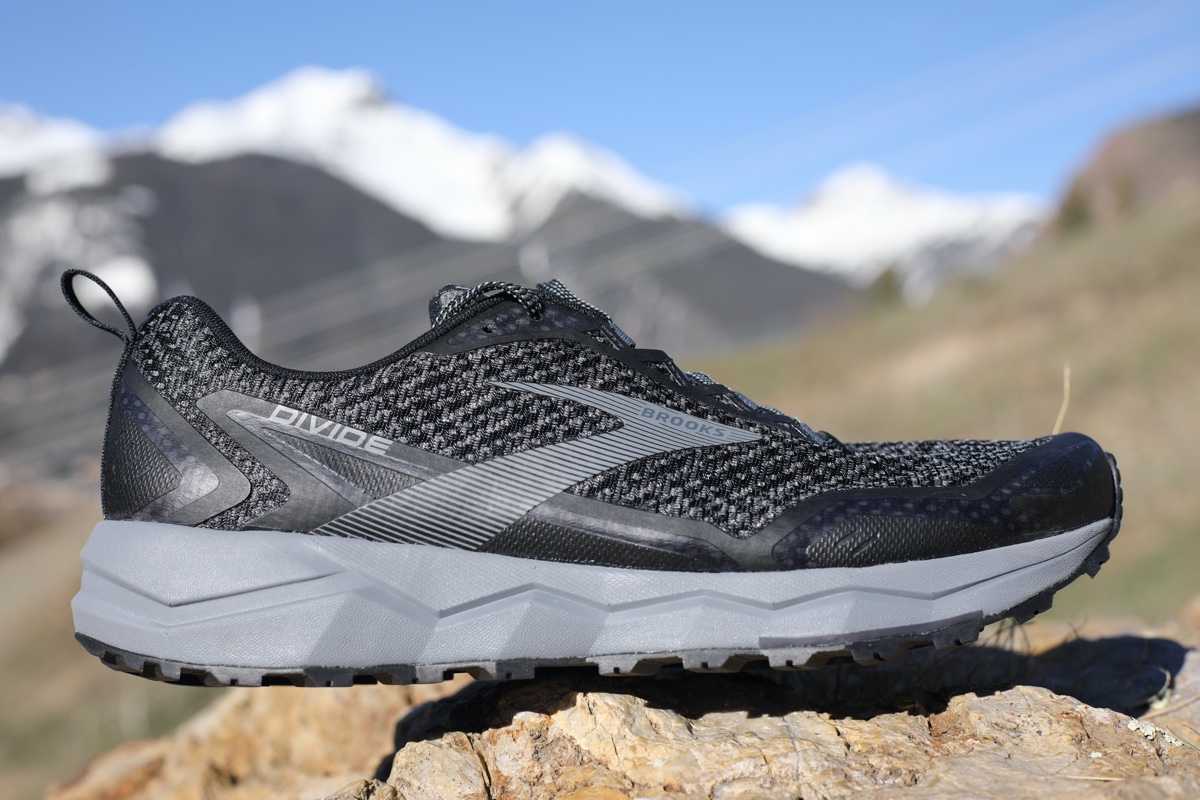For the latest on the Divide family, read our full Brooks Divide 5 review.
Our Favorite Trail Running Shoes
Check out our Best Trail Running Shoes buyer’s guide to learn about our current favorite trail running shoes!
Brooks Divide Review
The Brooks Divide ($100), described as having the “feel of a road shoe combined with the features of a trail shoe,” have been a great backyard option during our spring and early summer of 2020 “stay at home” scenario. They’re not only versatile for road to trail running, but they also have a very reasonable price point. My husband has suggested I add a picture of my bunions to all positive shoe reviews, claiming wonder/amazement would undoubtedly result if a reader saw what we were working with over here. I’ll spare you the photo, but I am pleased to report that for 300 miles thus far, the Brooks Divide have risen to the occasion, providing a comfortable 9.2-ounce ride (10.3 ounces for men) for even the unique contours of my feet.
Brooks Divide Upper
Backing up to day one, the first thing I appreciated about the Divide was how smoothly the laces slide through their eyelets. That quick stop mid-run to loosen/tighten laces has been forgone. Under the laces, the booty-style gusseted tongue makes for easy entry and also minimizes the need to tug/adjust/reposition. Some of my more trail-specific shoes sport that “in lieu of a gaiter,” sock-like collar around the ankle that keeps debris out; while the Divide lacks this element, perhaps that’s part of its appeal to those who are attracted to the road-shoe appearance and feel? Thermoplastic polyurethane (TPU) overlays offer protection against whatever you might kick up, surrounding a knit fabric that has had the durability to sustain hundreds of miles, yet the permeability to maintain adequate breathability. My feet have stayed both ventilated and reasonably dry despite rendezvous involving temperatures well into the 90s Fahrenheit and plentiful stream crossings/siestas.
Many reviews have mentioned how accommodating this shoe is to varying foot shapes/volumes; I happily join the positive feedback on fit. The Divide has been true to size (I run in a women’s 9), and while sufficiently snug for my narrow midfoot, remains roomy enough in the forefoot to be bunion friendly.
Beyond being both functional and comfortable, the knit upper is also attractive. Alongside a couple other shoes in my current quiver that are possibly more “flashy” in color/design (when they’re clean), the black/grey woven upper of the Divides wears dirt and mud the best.
Brooks Divide Midsole
Accustomed to road shoes with significant drop, the Divide met me halfway with an 8mm heel-toe drop via a stack height of 25mm at the heel and 17mm at the forefoot. Some reviewers of the Divide have been more aware of the location and resulting limited flex created by the rockplate when running on road. I can’t say I noticed any remarkable stiffness due to the rockplate on my way to the dirt; rather, I recall them being comfortable right out of the box, no break-in period required. Once on the rocky/eroded jeep roads I frequent, the added protection of the rockplate was notable and very much appreciated. I had a tender spot underfoot earlier this spring that has even dissipated since racking up miles in these trail running shoes. The midsole is composed of Brooks’s BioMoGo DNA, which is found in other Brooks models, and which touts itself as on the responsive end of the spectrum and adapting to individual runners’ mechanics.
Brooks Divide Outsole
The TrailTack outsole has low-profile lugs in a modified chevron pattern that are smooth on road and perform well on trail. I found them to have sufficient traction on wet/dry trail and rocky/rutty jeep road. I cannot speak to their versatility on snow/ice, though I have read positive reviews under those conditions as well. Personally, I would likely opt for more aggressive tread for especially muddy or snowy conditions. I don’t have much to report in the way of wear and tear aside from what appears to be relative resilience. Historically, the outsole of my road shoes have always worn in predictable spots; prior to fancy Strava/app features that tell us when our shoes are on their last mile, I relied on my soles to tell me. Three-hundred miles in, the soles of the Divide’s have nothing to say beyond, “keep running.”
Brooks Divide Overall Impressions
Intended as an introductory shoe for new trail runners, I am confident the Brooks Divide will continue to be a crowd pleaser for new and seasoned trail runners alike. Their versatility on road and trail, ability to get dirty without looking trashed, comfortable fit, resilience yet breathability, and competitive price point have won me over and make them an excellent choice for a broad range of runners and conditions.
Other Versions of the Brooks Divide
While we reviewed the men’s Brooks Divide in this article, be sure to also check out the Brooks Divide women’s version.
Call for Comments
- Do you run in the Brooks Divide? If so, what are your thoughts on the shoe overall?
- If you wear multiple Brooks models, how does it compare to others in the company’s line?
- Which features of the shoe do you like and which do you think could use a little work?
[Editor’s Note: If you’re affiliated (i.e., an employee, ambassador, etc.) with a brand, please share your relation in each of your comments on this article. Thanks!]





